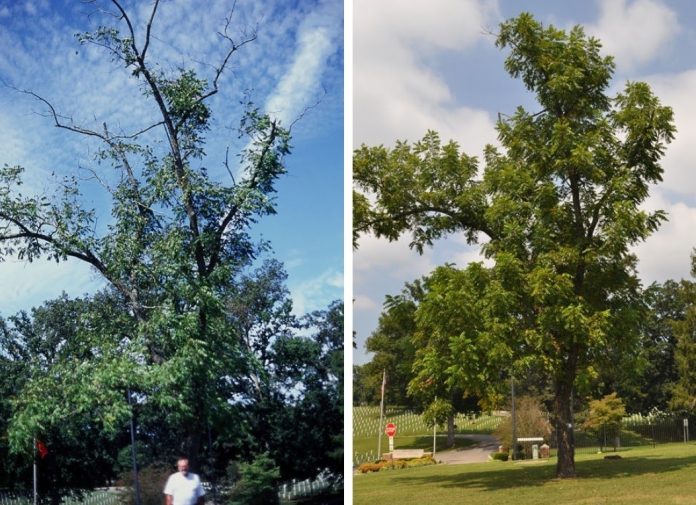Preemptive or pre-salvage harvesting of black walnut anywhere in Ohio, due to the presence of thousand cankers disease (TCD) in Butler County, is not justified, and not recommended.
Although TCD has been discovered in Ohio, it is not prevalent and there is no need to start cutting walnut trees due to this tree disease.
In fact, see below for information regarding how recent studies and observations have shown that TCD may not be a major cause of decline and mortality in black walnut trees in Ohio. It’s always best to call a forester before agreeing to sell your trees!
Hotline
The Call Before You Cut hotline number is 1-877-424-8288, or go to callb4ucut.com/ohio. A forester can evaluate whether harvesting is right for you and your woods and if so, help you develop a harvesting plan that meets your needs and assures healthy woodlands for the future.
What is thousand cankers disease, and from where did it originate? Thousand cankers disease (TCD) is a disease complex involving a fungus (Geosmithia morbida) that is carried into walnut trees by walnut twig beetles (Pityophthorus juglandis; WTB).
The fungus causes numerous small cankers (areas of dead plant tissue) just under the bark of twigs and stems near the entry points of the beetles, hence the name “thousand cankers disease.” The fungus and insect responsible for TCD are native to the southwestern United States and Mexico but have been accidentally introduced to areas in several western and eastern states.
First detection
The first detection of TCD in the eastern U.S. occurred in 2010 in Tennessee. In 2012, WTB was discovered in southwest Ohio in Butler County, caught in traps monitored by the Ohio Department of Natural Resources (ODNR) Division of Forestry.
The TCD fungus was identified in trees at the same site in 2013.
What is the threat from TCD, and what has been done?
Thousand cankers disease is a relatively new tree disease. Researchers are working on understanding its biology, impacts, and management with some recent key findings.
TCD’s impact on black walnut (Juglans nigra) seems to be more severe in the western U.S. than in the east. The reasons have not been proven but may be related to regional differences in growing conditions.
Black walnut is native to the eastern U.S., including all of Ohio. Though it is not native in the western U.S., it is planted there as an ornamental and for wood and nut production.
Soil and climate conditions in the west can be quite different from those of the native range of black walnut and may not be optimal for black walnut growth.
More susceptible
If trees are growing in sites where they are not well-suited, they can be more susceptible to attack and damage by pests and diseases. There is some evidence to show that drought-stressed black walnut trees infected with TCD in the East can recover from dieback after rainfall amounts return to normal.
Studies have shown that the fungus involved in TCD is a weak plant pathogen that likely would only do damage to trees that are already stressed, whether due to drought, poor site conditions, physical damage or other stressors.
In one study, researchers experimentally inoculated walnut branches in Ohio and Indiana with the Geosmithia fungus and were unable to kill any branches. Immediately after discovering walnut twig beetle and thousand cankers disease in Ohio, the Ohio Department of Agriculture imposed a quarantine, still in effect, restricting the movement of walnut material out of Butler County.
The quarantine is a precautionary measure levied to prevent the movement of the disease to new areas. Movement of plant material, including firewood, should always be minimized to limit potential spread of any plant pests or diseases.
Continued monitoring
Both the ODNR Division of Forestry and the Ohio Department of Agriculture continue to monitor traps across the state for possible new populations of WTB and the pathogen it carries. The population of WTB in Ohio appears to have crashed since 2013.
The reason for this is not known, but it is possible that the colder than average winters of 2013-14 and 2014-15 may have played a role. Cold winter temperature-induced mortality may limit the spread and establishment of walnut twig beetle).
What should I do with my walnut trees?
Recent studies and observations have shown that TCD may not be a major cause of decline and mortality in black walnut trees in Ohio. As a result, the recommendations to landowners with black walnut trees is to monitor their trees during the growing season for signs of branch dieback and to promote tree health.
Maintaining tree health
Tree health can be maintained by planting trees in appropriate sites, irrigating during drought, mulching to reduce soil compaction and reduce competition with other trees, and avoiding physical wounding from lawnmowers or other equipment.
If dieback is observed, contact the ODNR Division of Forestry at 614-265-6694 or the Ohio Department of Agriculture’s Plant Health Division at 614-728-6400. Potentially infected trees can also be reported using the Great Lakes Early Detection Network (GLEDN) reporting app via smartphones.
Experts can then determine whether TCD is present, and work with the landowner on a management strategy.










